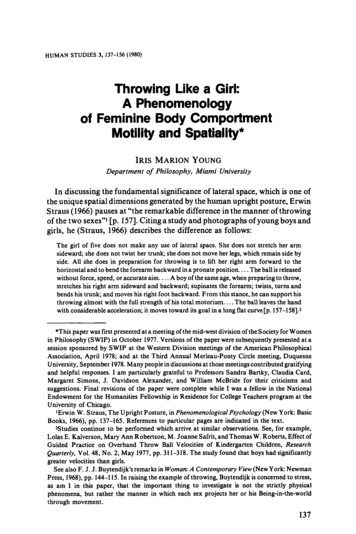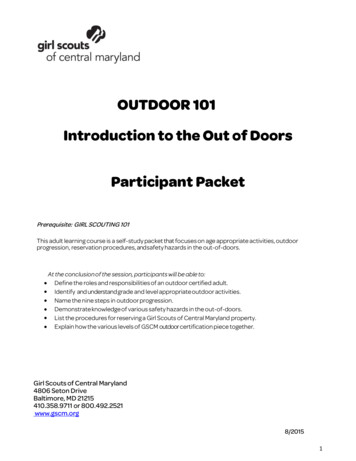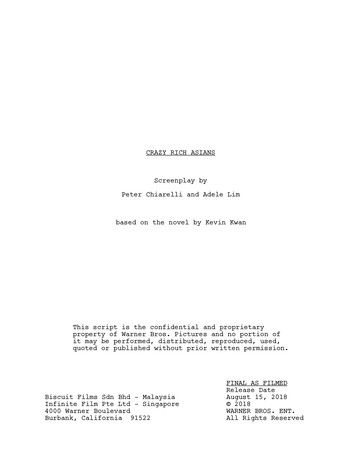
Transcription
HUMANSTUDIES 3, 137-156 (1980)Throwing Like a Girl:A Phenomenologyof Feminine Body ComportmentMotility and Spatiality*IRIS MARIONYOUNGDepartment of Philosophy, Miami UniversityI n d i s c u s s i n g t h e f u n d a m e n t a l s i g n i f i c a n c e o f l a t e r a l s p a c e , w h i c h is o n e o fthe unique spatial dimensions generated by the human upright posture, ErwinS traus (1966) pauses at "the remarkable difference in the manner of throwingo f t h e t w o s e x e s " ! [p. 157]. C i t i n g a s t u d y a n d p h o t o g r a p h s o f y o u n g b o y s a n dgirls, h e ( S t r a u s , 1966) d e s c r i b e s t h e d i f f e r e n c e as f o l l o w s :The girl of five does not make any use of lateral space. She does not stretch her armsideward; she does not twist her trunk; she does not move her legs, which remain side byside. All she does in preparation for throwing is to lift her right arm forward to thehorizontal and to bend the forearm backward in a pronate position . The ball is releasedwithout force, speed, or accurate aim . A boy oftbe same age, when preparing to throw,stretches his right arm sideward and backward; supinatcs the forearm; twists, turns andbends his trunk; and moves his tight foot backward. From this stance, he can support histhrowing almost with the full strength of his total motorium . The ball leaves the handwith considerable acceleration; it moves toward its goal in a long flat curve [p. 157-158]. 2*This paper was first presented at a meeting of the mid-west division of the Society for Womenin Philosophy (SWIP) in October 1977. Versions of the paper were subsequently presented at asession sponsored by SWIP at the Western Division meetings of the American PhilosophicalAssociation, April 1978; and at the Third Annual Merleau-Ponty Circle meeting, DuquesneUniversity, September 1978. Many people in discussions at those meetings contributed gratifyingand helpful responses. I am particularly grateful to Professors Sandra Bartky, Claudia Card,Margaret Simons, J. Davidson Alexander, and William McBride for their criticisms andsuggestions. Final revisions of the paper were complete while I was a fellow in the NationalEndowment for the Humanities Fellowship in Residence for College Teachers program at theUniversity of Chicago.KErwin W. Straus, The Uptight Posture, in Phenomenological Psychology (New York: BasicBooks, 1966), pp. 137-165. References to particular pages are indicated in the text.2Studies continue to be performed which arrive at similar observations. See, for example,Lolas E. Kalverson, Mary Ann Robertson, M. Joanne Safrit, andThomas W. Roberts, Effect ofGuided Practice on Overhand Throw Ball Velocities of Kindergarten Children, ResearchQuarterly, Vol. 48, No. 2, May 1977, pp. 311-318. The study found that boys had significantlygreater velocities than girls.See also F. J. J. Buytendijk's remarks in WomarL"A Contemporary View(New York: NewmanPress, 1968), pp. 144-115. In raising the example of throwing, Buytendijk is concerned to stress,as am 1 in this paper, that the important thing to investigate is not the strictly physicalphenomena, but rather the manner in which each sex projects her or his Being-in-the-worldthrough movement.137
138YOUNGThough he does not stop to trouble himself with the problem for long,Straus makes a few remarks in the attempt to explain this "remarkabledifference." Since the difference is observed at such an early age, he says, itseems to be "the manifestation of a biological, not an acquired, difference"[p.157]. He is somewhat at a loss, however, to specify the source of thedifference. Since the feminine style of throwing is observed in young children,it cannot result from the development of the breast. Straus (1966) providesfurther evidence against the breast by pointing out that "it seems certain" thatthe Amazons, who cut off their right breast, "threw a ball just like our Betty's,Mary's and Susan's" [p. 158]. Having thus dismissed the breast, Strausconsiders the weaker muscle power of the girl as an explanation of thedifference, but concludes that the girl should be expected to compensate forsuch relative weakness with the added preparation of reaching around andback. Straus explains the difference in style of throwing by referring to a"feminine attitude" in relation to the world and to space. The difference forhim is biologically based, but he denies that it is specifically anatomical. Girlsthrow in a way different from boys because girls are "feminine."What is even more amazing than this "explanation" is the fact that aperspective which takes body comportment and movement as definitive forthe structure and meaning of human lived experience devotes no more thanan incidental page to such a"remarkable difference" between masculine andfeminine body comportment and style of movement. For throwing is by nomeans the only activity in which such a difference can be observed. If there areindeed typically "feminine" styles of body comportment and movement, thenthis should generate for the existential phenomenologist a concern to specifysuch a differentiation of the modalities of the lived body. Yet Straus is by nomeans alone in his failure to describe the modalities, meaning, andimplications of the difference between "masculine" and "feminine" bodycomportment and movement.A virtue of Straus' account of the typical difference of the sexes in throwingis that he does not explain this difference on the basis of physical attributes.Straus is convinced, however, that the early age at which the differenceappears shows that it is not an acquired difference, and thus he is forced backonto a mysterious feminine essence in order to explain it. The feminist denialthat the real differences in behavior and psychology between men and womancan be attributed to some natural and eternal "feminine essence" is perhapsmost thoroughly and systematically expressed by de Beauvoir. Every humanexistence is defined by its situation; the particular existence of the femaleperson is no less defined by the historical, cultural, social, and economic limitsof her situation. We reduce women's condition simply to unintelligibility if we"explain" it by appeal to some natural and ahistorical feminine essence. Indenying such a feminine essence, however, we should not fall into that" n o m i n a l i s m " which denies the real differences in the behavior and
THROWING LIKE A GIRL139experiences of men and women. Even though there is no eternal feminineessence, there is (de Beauvoir, 1974) "a c o m m o n basis which underlies everyindividual female existence in the present state of education and custom. ''aThe situation of women within a given socio-historical set of circumstances,despite the individual variation in each woman's experience, opportunities,and possibilities, has a unity which can be described and made intelligible. Itshould be emphasized, however, that this unity is specific to a particular socialformation during a particular historical epoch.De Beauvoir (1974) proceeds to give such an account of the situation ofwomen with remarkable depth, clarity, and ingenuity. Yet she also to a largeextent, fails to give a place to the status and orientation of the woman's bodyas relating to its surroundings in living action. When de Beauvoir does talka b o u t the w o m a n ' s bodily being and her physical relation to hersurroundings, she tends to focus on the more evident facts of a woman'sphysiology. She discusses how women experience the body as a burden, howthe hormonal and physiological changes the body undergoes at puberty,during menstruation and pregnancy, are felt to be fearful and mysterious, andclaims that these phenomena weigh down the woman's existence by tying herto nature, immanence, and the requirements of the species at the expense ofher own individuality. 4 By largely ignoring the situatedness of the woman'sactual bodily movement and orientation to its surroundings and its world, deBeauvoir tends to create the impression that it is woman's anatomy andphysiology as s u c h which are at least in part determinative of her unfreestatus. 5This paper seeks to begin to fill a gap that thus exists both in existentialphenomenology and feminist theory. It traces in a provisional way some ofthe basic modalities of feminine body comportment, manner of moving, andrelation in space. It brings intelligibility and significance to certain observableand rather ordinary ways in which women in our society typically comportthemselves and move differently from the ways that men do. In accordancewith the existentialist concern with the situatedness of h u m a n experience, Imake no claim to the universality of this typicality of the bodily c o m p o r t m e n tof women and the phenonemological description based on it. The accountdeveloped here claims only to describe the modalities of feminine bodily Simone de Beauvoir, The Second Sex (New York: Vintage Books, 1974), p. xxxv. CLBuytendijk, pp. 275-276.4See Chapter I, The Date of Biology. Firestone claims that de Beauvoir's account served as the basis of her own thesis that theoppression of women is rooted in nature, and thus requires the transcendence of nature itselftobe overcome. See The Dialectic o f Sex (New York: Bantom Books, 1970). De Beauvoir wouldclaim that Firestone is guilty of desituating woman's situation by pinning a source on nature assuch. That Firestone would find inspiration for her thesis in de Beauvoir,however,indicates thatperhaps de Beauvoir has not steered away from causes in *nature" as much as is desirable.
140YOUNGexistence for w o m e n situated in c o n t e m p o r a r y advanced industrial, urban,and commercial society. Elements of the a c c o u n t developed here m a y or m a ynot apply to the situation of w o m a n in other societies and other epoch, but itis not the concern of this paper to determine to which, if any, other socialcircumstances this account applies.T h e scope of bodily existence and m o v e m e n t with which I a m concernedhere is also limited. I concentrate primarily on those sorts of bodily activitieswhich relate to the c o m p o r t m e n t or orientation of the b o d y as a whole, whichentail gross movement, or which require the enlistment o f strength and theconfrontation o f the body's capacities and possibilities with the resistance andmalleability o f things. Primarily the kind of m o v e m e n t I a m concerned with ism o v e m e n t in which the b o d y aims at the accomplishment of a definitepurpose or task. There are thus m a n y aspects of feminine bodily existencewhich I leave out of a c c o u n t here. M o s t notable o f these is the b o d y in itssexual being. A n o t h e r aspect of bodily existence, a m o n g others, which I leaveunconsidered is structured b o d y m o v e m e n t which does not have a particulara i m - - f o r example, dancing. Besides reasons of space, this limitation ofsubject is based on the conviction, derived primarily f r o m Merleau-Ponty,that it is the ordinary purposive orientation o f the b o d y as a whole towardthings and its environment which initially defines the relation o f a subject toits world. Thus focus u p o n ways in which the feminine b o d y frequently ortypically c o n d u c t s itself in such c o m p o r t m e n t or m o v e m e n t m a y beparticularly revelatory of the structures o f feminine existence. 6Before entering the analysis, I should clarify what I mean here by"feminine" existence. I n accordance with de Beauvoir's understanding, I take"femininity" to designate not a mysterious quality or essence which all w o m e nhave by virtue of their being biologically female. It is, rather, a set ofstructures and conditions which delimit the typical situation of being aw o m a n in a particular society, as well as the typical way in which this situationis lived by the w o m e n themselves. Defined as such, it is not necessary that anyw o m e n be " f e m i n i n e " - - t h a t is, it is not necessary that there be distinctivestructures a n d b e h a v i o r typical of the s i t u a t i o n o f w o m e n . 7 This6In his discussion of the "dynamics of feminine existence," Buytendijk focuses precisely onthose sorts of motions which are aimless. He claims that it is through these kinds of expressivemovements--e.g., walking for the sake of walking--and not through action aimed at theaccomplishment of particular purposes, that the pure image of masculine or feminine existence ismanifest (pp. 278-9). Such an approach, however, contradicts the basic existentialist assumptionthat Being-in-the-world consists in projecting purposes and goals which structure one'ssituatedness. While there is certainly something to be learned from reflecting upon femininemovement in noninstrumental activity, given that accomplishing tasks is basic to the structure ofhuman existence, it serves as a better starting point for investigation of feminine motility. As Ipoint out at the end of this paper, a full phenomenology of feminine existence must take accountof this noninstrumental movement.7It is not impossible, moreover, for men to be"feminine" in at least some respects, according tothe above definition.
THROWING LIKE A GIRL141understanding of "feminine" existence makes it possible to say that somewomen escape or transcend the typical situation and definition of women invarious degrees and respects. I mention this primarily to indicate that theaccount offered here of the modalities of feminine bodily existence is not to befalsified by referring to some individual women to whom aspects of theaccount do not apply, or even to some individual men to whom they do.The account developed here combines the insights of the theory of the livedbody as expressed by Merleau-Ponty and the theory of the situation ofwomen as developed by de Bcauvoir (1974). I assume that at the most basicdescriptive level, Merleau-Ponty's account of the relation of the lived body toits world, as developed in the Phenomenology of Perception (1962), applies toany human existence in a general way. At a more specific level, however, thereis a particular style of bodily comportment which is typical of feminineexistence, and this style consists of particular modalities of the structures andconditions of the body's existence in the w o r l d :As a framework for developing these modalities, I rely on de Bcauvoir'saccount of woman's existence in patriarchal society as defined by a basictension between immanence and transcendence. 9 The culture and society inwhich the female person dwells defines w o m a n as Other, as the inessentialcorrelate to man, as mere object and immanence. W o m a n is thereby bothculturally and socially denied by the subjectivity, autonomy, and creativitywhich are definitive of being human and which in patriarchal society areaccorded the man. At the same time, however because she is a humanexistence, the female person necessarily is a subjectivity and transcendenceand she knows herself to be. The female person who enacts the existence ofwomen in patriarchal society must therefore live a contradiction: as humanshe is a free subject who participates in transcendence, but her situation as awoman denies her that subjectivity and transcendence. M y suggestion is thatthe modalities of feminine bodily comportment, motility, and spatialityexhibit this same tension between transcendence and immanence, betweensubjectivity and being a mere object.Section I offers some specific observations about bodily comportment,physical engagement with things, ways of using the body in performing tasks,and bodily self-image, which I find typical of feminine existence. Section IIgives a general phenomenological account of the modalities of femininebodily c o m p o r t m e n t and motility. Section I I I develops these modalitiesfurther in terms of the spatiality generated by them. Finally, in Section IV, Idraw out some of the implications of this account for an understanding of the80n this level of specificity there also exist particular modalities of masculine motility,inasmuch as there is a particular style of movement more or less typical of men. I will not,however, be concerned with those in this paper.9See de Beauvoir, Chapter XXI, Woman's Situation and Character.
142YOUNGoppression of women, as well as raise some further questions about feminineBeing-in-the-world which require further investigation.The basic difference which Straus observes between the way boys and girlsthrow is that girls do not bring their whole bodies into the motion as much asthe boys. They do not reach back, twist, move backward, step, and leanforward. Rather, the girls tend to remain relatively immobile except for theirarms, and even the arm is not extended as far as it could be. Throwing is notthe only movement in which there is a typical difference in the way men andwomen use their bodies. Reflection on feminine comportment and bodymovement in other physical activities reveals that these also are frequentlycharacterized, much as in the throwing case, by a failure to make full use ofthe body's spatial and lateral potentialities.Even in the most simple body orientations of men and women as they sit,stand, and walk, one can observe a typical difference in body style andextension. Women generally are not as open with their bodies as men in theirgait and stride. Typically, the masculine stride is longer proportional to aman's body than is the feminine stride to a woman's. The man typically swingshis arms in a more open and loose fashion than does a woman and typicallyhas more up and down rhythm in his step. Though we now wear pants morethan we used to, and consequently do not have to restrict our sitting posturesbecause of dress, women still tend to sit with their legs relatively close togetherand their arms across their bodies. When simply standing or leaning, mentend to keep their feet further apart than do woman, and we also tend more tokeep our hands and arms touching or shielding our bodies. A final indicativedifference is the way each carries books or parcels; girls and women mostoften carry books embraced to their chests, while boys and men swing themalong their sides.The approach persons of each sex take to the performance of physical tasksthat require force, strength, and muscular coordination is frequentlydifferent. There are indeed real physical differences between men and womanin the kind and limit of their physical strength. Many of the observeddifferences between men and women in the performance of tasks requiringcoordinated strength, however, are due not so much to brute muscularstrength, but to the way each sex u s e s the body in approaching tasks. Womenoften do not perceive themselves as capable of lifting and carrying heavythings, pushing and shoving with significant force, pulling, squeezing,grasping, or twisting with force. When we attempt such tasks, we frequentlyfail to summon the full possibilities of our muscular coordination, position,poise, and bearing. Women tend not to put their whole bodies intoengagement in a physical task with the same ease and naturalness as men. For
THROWING LIKE A GIRL143example, in attempting to lift something, women more often than men fail toplant themselves firmly and make their thighs bear the greatest proportion ofthe weight. Instead, we tend to concentrate our effort on those parts of thebody most immediately connected to the task--the arms and shoulders-rarely bringing the power of the legs to the task at all. When turning ortwisting something, to take another example, we frequently concentrateeffort in the hand and wrist, not bringing to the task the power of theshoulder, which is necessary for its efficient performance. oThe previously cited throwing example can be extended to a great deal ofathletic activity. Now most men are by no means superior athletes, and theirsporting efforts more often display bravado than genuine skill andcoordination. The relatively untrained man nevertheless engages in sportgenerally with more free motion and open reach than does his femalecounterpart. Not only is there a typical style of throwing like a girl, but there isa more or less typical style of running like a girl, climbing like a girl, swinginglike a girl, hitting like a girl. They have in common, first, that the whole bodyis not put into fluid and directed motion, but rather, in swinging and hitting,for example, the motion is concentrated in one body part; and second, thatthe woman's motin tends not to reach, extend, lean, stretch, and followthrough in the direction of her intention.For many women as they move in sport, a space surrounds them inimagination which we are not free to move beyond; the space available to ourmovement is a constricted space. Thus, for example, in softball or volley ballwomen tend to remain in one place more often than men, neither jumping toreach nor running to approach the ball. Men more often move out toward aball in flight and confront it with their own countermotion. Women tend towait for and then r e a c t to its approach rather than going forth to meet it. Wefrequently respond to the motion of a ball coming toward us as though it werecoming at us, and our immediate bodily impulse is to flee, duck, or otherwiseprotect ourselves from its flight. Less often than men, moreover, do womengive self-conscious direction and placement to their motion in sport. Ratherthan aiming at a certain place where we wish to hit a ball, for example, we tendto hit it in a "general" direction.Women often approach a physical engagement with things with timidity,uncertainty, and hesitancy. Typically, we lack an entire trust in our bodies tocarry us to our aims. There is, I suggest, a double hesitation here. On the onehand, we often lack confidence that we have the capacity to do what must be should be noted that this is probably typical only of women in advanced industrialsocieties, where the model of the Bourgeois woman has been extended to most women. It wouldnot apply to those societies, for example, where most people, including women, do heavyphysical work. Nor does this particular observation, of course, hold true of those women in ourown society who do heavy physical work.
144YOUNGdone. M a n y times I have slowed a hiking party in which the men boundedacross a harmless stream while I stood on the other side warily testing out myfooting on various stones, holding on to overhanging branches. T h o u g h theothers crossed with ease, I do not believe it is easy for me, even t h o u g h once Itake a committed step I a m across in a flash. The other side o f thistentativeness is, I suggest, a fear of getting hurt, which is greater in w o m e nthan in men. O u r attention is often divided between the aim to be realized inm o t i o n and the body that must accomplish it, while at the same time savingitself f r o m harm. We often experience our bodies as a fragile encumberance,rather than the media for the enactment of our aims. We feel as though wemust have our attention directed u p o n our b o d y to make sure it is d o i n g w h a twe wish it to do, rather than paying attention to what we want to do throughour bodies.All the above factors operate to produce in m a n y w o m e n a greater or lesserfeeling of incapacity, frustration, and self-consciousness. We have more of atendency than men to greatly underestimate our bodily capacity. I We decideb e f o r e h a n d - - u s u a l l y m i s t a k e n l y - - t h a t the task is beyond us, and thus give itless than our full effort. At such a half-hearted level, of course, we c a n n o tperform the tasks, become frustrated, and fulfill o u r own prophecy. Inentering a task we frequently are self-conscious about appearing awkward,and at the same time do not wish to appear too strong. Both worriescontribute to our awkwardness and frustration. If we should finally releaseourselves f r o m this spiral and really give a physical task our best effort, we aregreatly surprised indeed at what our bodies can accomplish. It has been f o u n dthat w o m e n more often than men underestimate the level of achievement theyhave reached. 12N o n e of the observations which have been made thus far about the wayw o m e n typically move and c o m p o r t their bodies applies to all w o m e n all ofthe time. N o r do those w o m e n who manifest some aspect of this typicality doso in the same degree. There is no inherent, mysterious connection betweenthese sorts o f typical c o m p o r t m e n t s and being a female person. M a n y o f themresult, as will be developed later, from lack of practice in using the body andperforming tasks. Even given these qualifications, one can neverthelesssensibly speak of a general feminine style of b o d y c o m p o r t m e n t andmovement. T h e next section will develop a specific categorical description ofthe modalities of the c o m p o r t m e n t and movement."See A. M. Gross, Estimated versus actual physical strength in three enthnic groups, ChildDevelopment, 39 (1968), pp. 283-90. In a test of children at several different ages, at all but theyoungest age-level, girls rated themselves lower than boys and rated themselves on self-estimatesof strength, and as the girls grow older, their self-estimates of strength become even lower.nSee Marguerite A. Cifton and Hope M Smith, Comparison of Expressed Self-Concept ofHighly Skilled Males and Females Concerning Motor Performance, Pereeplual and MotorSkills, 16 (1963), pp. 199-201. Women consistently underestimated their level of acheivement inskiUs like running and jumping far more often than men did.
THROWING LIKE A GIRL145IIThe three modalities of feminine motility are that feminine movementexhibits an ambiguous transcendence, an inhibited intentionality, and adiscontinuous unity with its surroundings. A source of these contradictorymodalities is the bodily self-reference of feminine comportment, whichderives from the woman's experience of her body as a thing at the same timethat she experiences it as a capacity.1. In his Phenomenology of Perception,13 M erleau-Ponty (1962) takes ashis task the articulation of the primordial structures of existence, which areprior to and the ground of all reflective relation to the world. In asking howthere can be a world for a subject, Merleau-Ponty reorients the entiretradition of that questioning by locating subjectivity not in mind orconsciousness, but in the body. Merleau-Ponty gives to the lived body theontological status which Sartre, as well as "intellectualist" thinkers beforehim, attribute to consciousness alone: the status of transcendence as beingfor-itself. It is the body in its orientation toward and action upon and withinits surroundings which constitutes the initial meaning giving act (p. 121; pp.146-147). The body is the first locus of intentionality, as pure presence to theworld and openness upon its possibilities. The most primordial intentionalact is the motion of the body orienting itself with respect to and moving withinits surroundings. There is a world for a subject just insofar as the body ascapacities by which it can approach, grasp, and appropriate its surroundingsin the direction of its intentions.While feminine bodily existence is a transcendence and openness to theworld, it is an ambiguous transcendence, a transcendence which is at the sametime laden with immanence. Now once we take the locus of subjectivity andtranscendence to be the lived body rather than pure consciousness, alltranscendence is ambiguous because the body as natural and material isimmanence. But it is not the ever present possibility of any lived body to bepassive, to be touched as well as touching, to be grasped as well as grasping,which I am referring to here as the ambiguity of the transcendence of thefeminine lived body. The transcendence of the lived body which MerleauPonty describes is a transcendence which moves out from the body in itsimmanence in an open and unbroken directedness upon the world in action.The lived body as transcendence is pure fluid action, the continuous callingforth of capacities, which are applied to the world. Rather than simplybeginning in immanence, feminine bodily existence remains in immanence, orbetter is overlaid with immanence, even as it moves out toward the world inmotions of grasping, manipulating, and so on.*JMaurice Merleau-Ponty, Phenomenology of Perception, Colin Smith, trans. (New York:Humanities Press, 1962). All references to this work are noted in parentheses within the text.
146YOUNGIn the previous section, I observed that a woman typically refrains fromthrowing her whole body into a motion, and rather concentrates motin in onepart of the body alone while the rest of the body remains relatively immobile.Only a part of the body, that is, moves out toward a task while the rest remainsrooted in immanence. I also observed earlier that a woman frequently doesnot trust the capacity of her body to engage itself in physical relation to things.Consequently, she often lives her body as a burden, which must be draggedand prodded along, and at the same time protected.2. Merleau-Ponty locates intentionality in motility (pp. 110-112); thepossibilities which are opened up in the world depend on the mode and limitsof the bodily "I can" (p. 137, p. 148). Feminine existence, however, often doesnot enter bodily relation to possibilities by its own comportment toward itssurroundings in an unambiguous and confident "I can." F o r example, asnoted earlier, women frequently tend to posit a task which would beaccomplished relatively easily once attempted as beyond their capacitiesbefore they begin it. Typically, the feminine body underuses its real capacity,both as the potentiality of its physical size and strength and as the real skillsand coordination which are available to it. Feminine bodily existence is aninhibited intentionality, which simultaneously re
The girl of five does not make any use of lateral space. She does not stretch her arm sideward; she does not twist her trunk; she does not move her legs, which remain side by side. All she does in preparation for throwing is to lift her right arm forward to the










